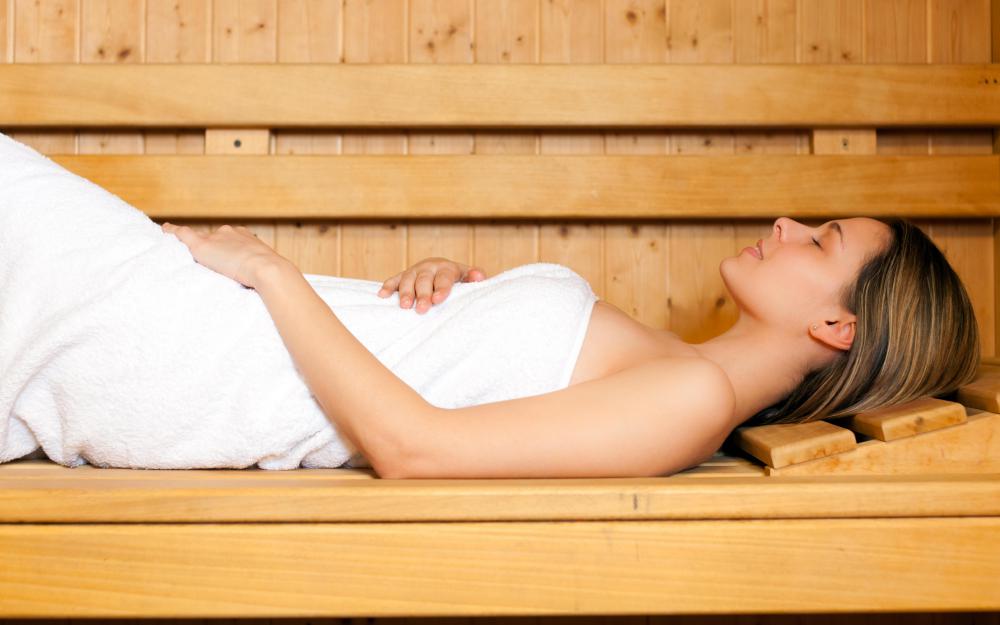At BeautyAnswered, we're committed to delivering accurate, trustworthy information. Our expert-authored content is rigorously fact-checked and sourced from credible authorities. Discover how we uphold the highest standards in providing you with reliable knowledge.
What is a Sauna?
A sauna is a small room designed to be heated to very high temperatures, with well-controlled humidity. Saunas are used both for recreational and therapeutic purposes, with most people using to relax, as well as for their health benefits. Most are built of aromatic wood, which releases pleasing aromas as they heat.
There are two main types of saunas: dry and wet. Which type you prefer is just a matter of taste. Wet saunas are sometimes called steam rooms, and are kept at lower temperatures than their dry counterparts — usually between 100 to 115°F (37 to 46°C) to prevent the superheated water from scalding the skin on contact. Dry saunas may be kept at much higher temperatures of up to 250 Fahrenheit (121 Celsius), by keeping the ambient moisture down to nearly zero.

Many saunas, even those using electric heaters, have some form of hot fragrant rocks which may be splashed with water to release both a short burst of steam, (temporarily creating the impression of a higher temperature), and a pleasing aroma. Some wood-burning ones choose their fuels very carefully to help stimulate the participants through scent.
Many cultures have independently created their own form of hot room. The Finnish sauna, which is by far the most popular globally, originated as a hole in the ground with a fire in the middle and an insulating roof. Many First Nations people of North America use a traditional sweat lodge. These may be as simple as a hole dug in the ground, or as complex as an entire wooden long-house style structure. In most First Nations' saunas there is no internal fire; instead, stones are heated in a fire outside of the building and transported into the sweat lodge. Even many desert peoples have their own variants of the sauna, usually with full humidity and lower temperatures.

Saunas are thought by many to be best used alternating hot and cold. To this end, spending enough time in the room to become hot, and then leaving it to cool back down, before repeating, is an ideal way to use the sauna to its full potential. Many people enjoy jumping into very cold water between sessions. This shock is thought by some to be good for the immune system, though others hold it can be detrimental to one's health. Those with high blood pressure should be especially careful of this immediate transition from hot to cold, as it spikes blood pressure for brief periods.

Alcohol should never be used in tandem with a sauna, but should be particularly avoided if one has a low blood pressure. Spending time in intense heat causes surface capillaries to dilate, lowering blood pressure even further. When mixed with alcohol this can cause lightheadedness or fainting.
AS FEATURED ON:
AS FEATURED ON:














Discussion Comments
I like wet saunas. I just think a dry sauna is too hot.
Will sauna reduce skin color? I am brown skinned, and I feel these days after going to the suana, I became a bit darker. Can you please say if a sauna or steam room reduces body color?
I'm a Finnish 30 year old and I just love sauna so much! I take sauna three to four times/week. It is a good way to relax. I usually drink juice or mineral water in the sauna, but I have noticed that some old people do not like it when I drink in the sauna. So nowadays I do that only in my sauna (apartment) Sauna is a "serious" thing for older finns.
The traditional day for Finnish people for sauna is Saturday evening, some people have sauna also on Wednesdays, and some visit the sauna even more often.
For sure you can feel the difference in your body after only one sauna visit as well, but regularly visited, of course the benefits are greater. I warmly recommend the sauna. It is a great experience, and after you just feel so relaxed, both physically and mentally.
I would be interesting in hearing how often people take saunas and for how long? Does it help anything to do it once in a while or does it need to be regular? What are the benefits?
As a Finnish person who was basically ´born´ in the sauna, I am glad to see a good article written about sauna and the difference of it when comparing to steam room. I would like to mention also the mental aspect of sauna, which is often ignored (maybe because it is a bit difficult to explain), but is very important part of sauna culture and experience.
Having sauna is almost like a religious, spiritual experience, it freshens the body and soul, and makes you feel like you"re ´born again´. Usually (best) Finnish saunas are located on the countryside, by the lake, where all four elements are present, earth, wind, fire and water. Combined by the beautiful landscape (the calm lake, green trees and big, orange sun shining just above the trees in the evenings) and great silence (maybe some birds are singing, trees whispering in the wind, or water making a gentle sound), the sauna experience is something that gently nurtures all your senses, not only body, but soul, as well.
I love to see someone writing about the honest benefits and enjoyment of saunas and steam rooms, but I feel I must point out that they really are two different things.
A steam room/steam shower is not a sauna. A sauna is constructed out of porous material (such as High Grade Cedar), while a steam room is constructed of something completely nonporous, such as plastic (like the material a regular shower/bath would be constructed out of).
Steam rooms also use steam generators, which directly heat the water, creating clouds of steam. The difference here is that in a wet or "steam" sauna bathers would utilize the compartment of stones to create steam by throwing water on them (this is the Finnish practice known as Loyly).
Tylo does make a great electric sauna heater that has an extra deep stone compartment, which leaves room for the "patented double side vents", which allow the heater to reach maximum heat in half the time of other brands.
Many sauna bathers do enjoy the cold shock after their sauna bath, but you are right to advise people with high blood pressure to abstain from this practice. If any bathers thinks a health condition might be made worse by the cold shock they should definitely check with their physician prior to engaging in such an act.
Thanks again for this article! I really enjoyed it.
I love to use a dry sauna. 10 minutes at high heat, then a cool down period. I repeat that three times. I have heard that many of the toxins are flushed out of your body by sweating them out. About 20 or 30 minutes after the session, if you sit or lay quietly, it feels like you are floating.
Post your comments